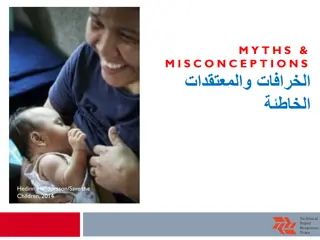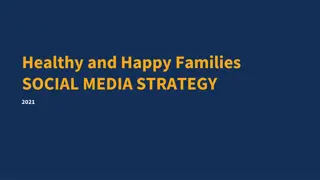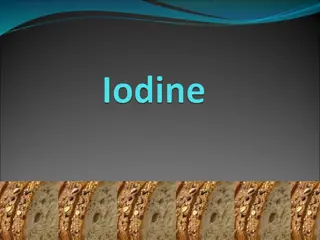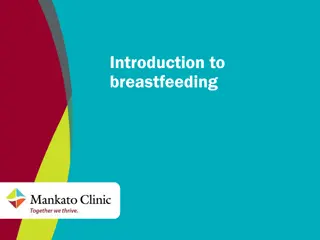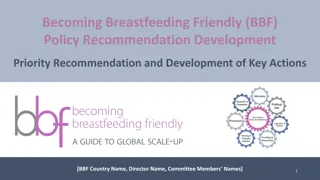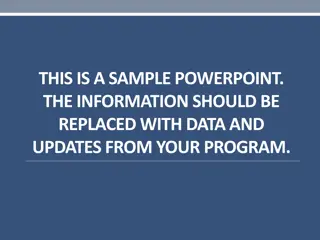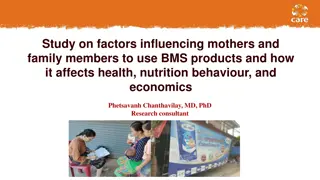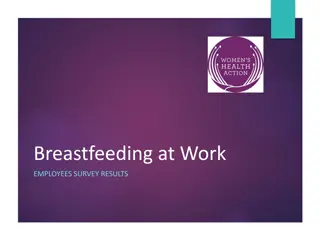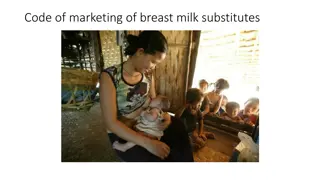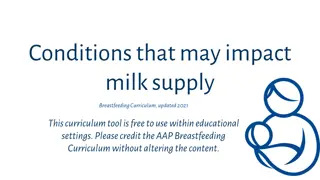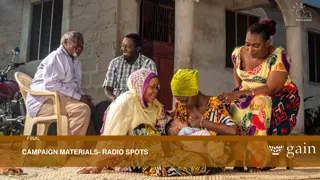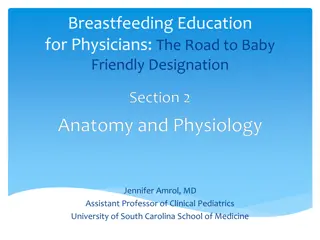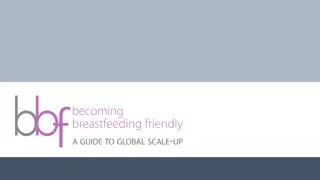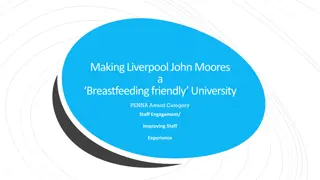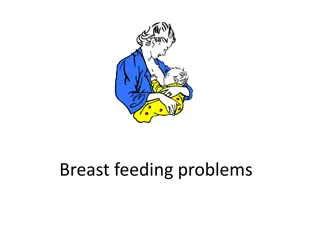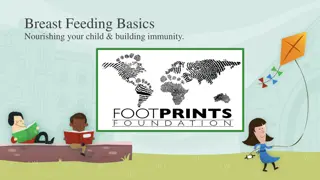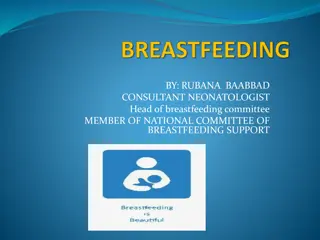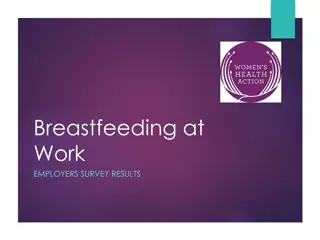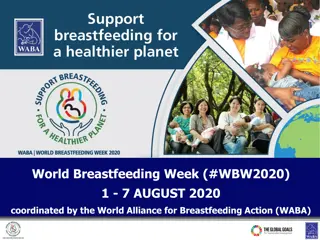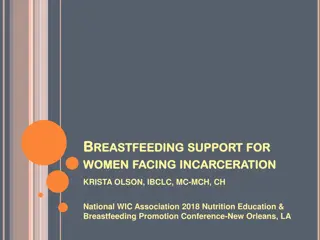Comprehensive Breastfeeding Training Program for Health Care Professionals
This presentation covers a detailed review of health provider schools and pre-service education programs focusing on breastfeeding topics for professionals caring for mothers, infants, and young children. It assesses the adequacy of budget allocation, hands-on training for facility-based and community-based health care professionals, as well as community health workers and volunteers. The content emphasizes essential breastfeeding counseling and support skills and highlights the responsibilities outlined in the Code implementation.
Download Presentation

Please find below an Image/Link to download the presentation.
The content on the website is provided AS IS for your information and personal use only. It may not be sold, licensed, or shared on other websites without obtaining consent from the author.If you encounter any issues during the download, it is possible that the publisher has removed the file from their server.
You are allowed to download the files provided on this website for personal or commercial use, subject to the condition that they are used lawfully. All files are the property of their respective owners.
The content on the website is provided AS IS for your information and personal use only. It may not be sold, licensed, or shared on other websites without obtaining consent from the author.
E N D
Presentation Transcript
Training & Program Delivery Meeting 3 Presentation Name of the presenter Gear Team Members: XX 2018
TPDG1: A review of health provider schools and pre-service education programs for health care professionals that will care for mothers, infants and young children indicates that there are curricula that cover essential topics of breastfeeding. **Copy and paste information from Gear Packages or insert Pathway and table Date Scoring Justification Primary Score X Final Score Data Source Gaps identified xx.xx.18 xx.xx.18 X Appendix 2
TPDG2: The budget is adequate for breastfeeding protection, promotion and support activities. **Copy and paste information from Gear Packages or insert Pathway and table Date Scoring Justification Primary Score X Final Score Data Source Gaps identified xx.xx.18 xx.xx.18 X Appendix 2
TPDG3: Facility-based health care professionals who care for mothers, infants and young children receive hands-on training in essential topics for counseling and support skills for breastfeeding. **Copy and paste information from Gear Packages or insert Pathway and table Date Scoring Justification Primary Score X Final Score Data Source Gaps identified xx.xx.18 xx.xx.18 X Appendix 2
TPDG4: Community-based health care professionals who care for mothers, infants and young children are trained on the essential breastfeeding topics as well as their responsibilities under the Code implementation. **Copy and paste information from Gear Packages or insert Pathway and table Date Scoring Justification Primary Score X Final Score Data Source Gaps identified xx.xx.18 xx.xx.18 X Appendix 2
TPDG5: Community-based health care professionals who care for mothers, infants and young children receive hands-on training in essential topics for counseling and support skills for breastfeeding. **Copy and paste information from Gear Packages or insert Pathway and table Date Scoring Justification Primary Score X Final Score Data Source Gaps identified xx.xx.18 xx.xx.18 X Appendix 2
TPDG6: Community health workers and volunteers that work with mothers, infants and young children are trained on the essential breastfeeding topics as well as their responsibilities under the Code implementation. **Copy and paste information from Gear Packages or insert Pathway and table Date Scoring Justification Primary Score X Final Score Data Source Gaps identified xx.xx.18 xx.xx.18 X Appendix 2
TPDG7: Community health workers and volunteers that work with mothers, infants and young children receive hands-on training in essential topics for counseling and support skills for breastfeeding. **Copy and paste information from Gear Packages or insert Pathway and table Date Scoring Justification Primary Score X Final Score Data Source Gaps identified xx.xx.18 xx.xx.18 X Appendix 2
TPDG8: There exist national/subnational master trainers in breastfeeding (i.e. breastfeeding specialists or lactation consultants) who give support and training to facility-based and community-based health care professionals as well as community health workers. **Copy and paste information from Gear Packages or insert Pathway and table Date Scoring Justification Primary Score X Final Score Data Source Gaps identified xx.xx.18 xx.xx.18 X Appendix 2
TPDG9: Breastfeeding training programs that are delivered by different entities through different modalities (e.g. face-to-face; on-line learning) are coordinated. **Copy and paste information from Gear Packages or insert Pathway and table Date Scoring Justification Primary Score X Final Score Data Source Gaps identified xx.xx.18 xx.xx.18 X Appendix 2
TPDG10: Breastfeeding information and skills are integrated into related training programs (e.g. maternal and child health, IMCI). **Copy and paste information from Gear Packages or insert Pathway and table Date Scoring Justification Primary Score X Final Score Data Source Gaps identified xx.xx.18 xx.xx.18 X Appendix 2
TPDG11: National standards and guidelines for breastfeeding promotion and support have been developed and disseminated to all facilities and personnel providing maternity and newborn care. **Copy and paste information from Gear Packages or insert Pathway and table Date Scoring Justification Primary Score X Final Score Data Source Gaps identified xx.xx.18 xx.xx.18 X Appendix 2
TPDG12: Assessment systems are in place for designating BFHI/Ten Steps facilities. **Copy and paste information from Gear Packages or insert Pathway and table Date Scoring Justification Primary Score X Final Score Data Source Gaps identified xx.xx.18 xx.xx.18 X Appendix 2
TPDG13: Reassessment systems are in place to reevaluate designated Baby-Friendly/Ten Steps hospitals or maternity services to determine if they continue to adhere to the Baby- Friendly/Ten Steps criteria. **Copy and paste information from Gear Packages or insert Pathway and table Date Scoring Justification Primary Score X Final Score Data Source Gaps identified xx.xx.18 xx.xx.18 X Appendix 2
TPDG14: More than 66.6% of deliveries take place in hospitals and maternity facilities designated or reassessed as Baby Friendly in the last years. **Copy and paste information from Gear Packages or insert Pathway and table Date Scoring Justification Primary Score X Final Score Data Source Gaps identified xx.xx.18 xx.xx.18 X Appendix 2
TPDG15: Health care facility-based community outreach and support activities related to breastfeeding are being implemented. **Copy and paste information from Gear Packages or insert Pathway and table Date Scoring Justification Primary Score X Final Score Data Source Gaps identified xx.xx.18 xx.xx.18 X Appendix 2
TPDG16: Community-based breastfeeding outreach and support activities have national coverage. **Copy and paste information from Gear Packages or insert Pathway and table Date Scoring Justification Primary Score X Final Score Data Source Gaps identified xx.xx.18 xx.xx.18 X Appendix 2
TPDG17: There are trained and certified lactation management specialists available to provide supportive supervision for breastfeeding program delivery. **Copy and paste information from Gear Packages or insert Pathway and table Date Scoring Justification Primary Score X Final Score Data Source Gaps identified xx.xx.18 xx.xx.18 X Appendix 2
Training & Program Delivery - GEAR TOTAL SCORE BENCHMARKS FINAL SCORES BENCHMARKS FINAL SCORES Benchmark TPDG1 Benchmark TPDG11 Benchmark TPDG2 Benchmark TPDG3 Benchmark TPDG12 Benchmark TPDG13 Benchmark TPDG4 Benchmark TPDG14 Benchmark TPDG5 Benchmark TPDG6 Benchmark TPDG15 Benchmark TPDG16 Benchmark TPDG7 Benchmark TPDG17 Benchmark TPDG8 Benchmark TPDG9 Gear Total Score GTS- Training & Program Delivery x.xx Benchmark TPDG10 Appendix 2Interpretation: XX Gear Strength (Range x.x-x.x)
PG: Gaps and Recommendations Recommendations Gaps Extracted from tables on previous slides Appendix 2
Recommendation 1 Initial Recommendation WHAT do we want to happen? WHY is it important for this activity to be accomplished? WHEN should this activity be completed by? HOW will these activities get done? HAVE similar actions been effective in enabling the breastfeeding environment in other contexts? (Provide examples and use EBBs.) Revisions proposed in meeting 3 discussion Appendix 2
Recommendation 2 Initial Recommendation WHAT do we want to happen? WHY is it important for this activity to be accomplished? WHEN should this activity be completed by? HOW will these activities get done? HAVE similar actions been effective in enabling the breastfeeding environment in other contexts? (Provide examples and use EBBs.) Revisions proposed in meeting 3 discussion Appendix 2
Recommendation 3 Initial Recommendation WHAT do we want to happen? WHY is it important for this activity to be accomplished? WHEN should this activity be completed by? HOW will these activities get done? HAVE similar actions been effective in enabling the breastfeeding environment in other contexts? (Provide examples and use EBBs.) Revisions proposed in meeting 3 discussion Appendix 2
Recommendation 4 Initial Recommendation WHAT do we want to happen? WHY is it important for this activity to be accomplished? WHEN should this activity be completed by? HOW will these activities get done? HAVE similar actions been effective in enabling the breastfeeding environment in other contexts? (Provide examples and use EBBs.) Revisions proposed in meeting 3 discussion Appendix 2
Criteria and Questions for Grading Recommendations These top 3 criteria were chosen via a survey of BBF TAG members and country representatives from an original list of 8. Questions to assess each criteria developed by Yale BBF Team. Criteria Explanation Effectiveness Will this recommendation positively effect or impact breastfeeding outcomes? This is primarily assessed through understanding the existing evidence of the effect/impact of this recommendation elsewhere. Affordability Is this recommendation financially viable? This is based on available information on costs of implementing and the likely means to pay for it. Feasibility Are the necessary resources to implement the recommendation present? 26
References Appendix 2



